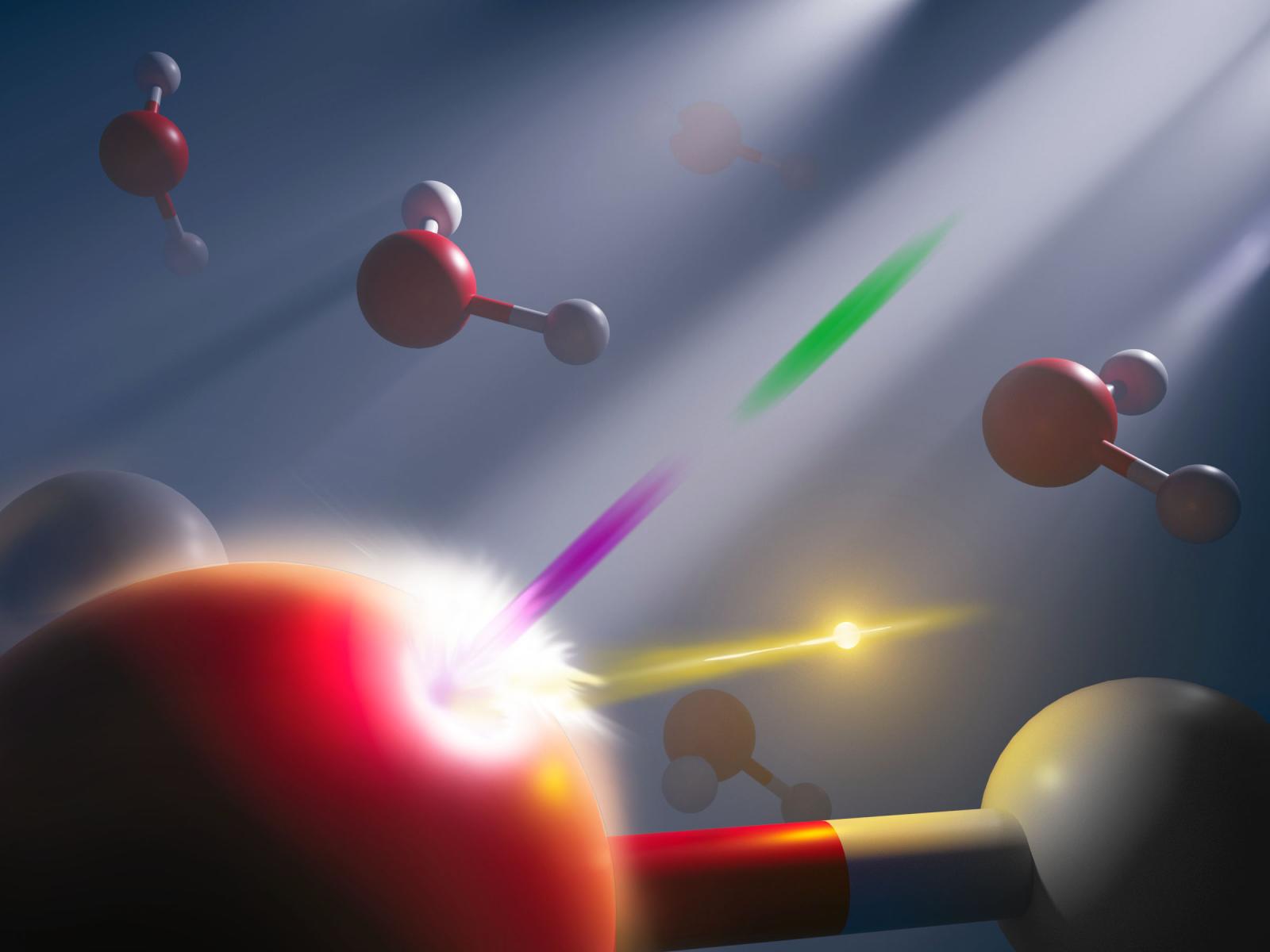Attosecond X-rays Provide a Snapshot of Liquid Water
Scientists capture electronic response to ionization

Scientists used a synchronized pair of attosecond X-ray pulses (pictured in pink and green here) from an X-ray free electron laser to study the response of electrons (gold) in liquid water on attosecond timescale, while the hydrogen (white) and oxygen (red) atoms are "frozen" in time.
(Image by Nathan Johnson | Pacific Northwest National Laboratory)
The Science
At the subatomic level, electrons move so fast that attosecond strobe pulses are required to capture their motion. Researchers performed the first all X-ray attosecond-pump attosecond-probe experiment in condensed phase to observe electron motion, defining a method for spectral snapshots free of nuclear motion. The researchers established a technique called all X-ray attosecond transient absorption spectroscopy (AX-ATAS)—which involves synchronized attosecond X-ray pulse pairs—to study the electronic response to valence ionization in liquid water. This experiment provides the first real-time observation of X-ray induced electron dynamics at subfemtosecond timescales in the condensed phase.
The Impact
The study resolves a long-standing debate about the splitting observed in the X-ray emission spectrum of liquid water. It provides evidence that the splitting is due to dynamics and not two structural motifs, as previously thought. The methodology also enables future studies of the origin and evolution of reactive species produced by radiation-induced processes. As these processes are initiated by electronic motion at attosecond timescales, this technique is critical for understanding ultrafast reactions.
Summary
The all X-ray attosecond transient absorption spectroscopy (AX-ATAS) experiment was performed on liquid water using synchronized attosecond X-ray pulse pairs from the Linac Coherent Light Source operating in a harmonic configuration, omega (ω) and 2ω. The X-rays were focused on a thin, flat sheet of liquid water. The ω pump pulse ionized the valence band of liquid water, and the 2ω probe pulse interrogated the electronic structure.
The researchers’ model showed that the polarization response in condensed-phase media observed with AX-ATAS is confined to the sub-femtosecond timescale, such that the resulting experimental spectra are free from nuclear motion. The researchers were then able to model the X-ray absorption spectra of the instantaneous post-ionization electronic structure using multi-reference restricted-active-space configuration interaction with fixed nuclear geometry. The findings, reported in the journal Science, provide a new window into the electronic structure of molecules in the liquid phase on a timescale previously unattainable with X-rays. The new technique reveals the immediate electronic response when a target is hit with an X-ray, an important step in understanding the effects of prolonged exposure to ionizing radiation. This research opens the doors for future work with more complex radiation-induced chemical solutions, like those found in legacy nuclear tank waste.
Experimental work used the resources of the Linac Coherent Light Source (LCLS) at SLAC National Accelerator Laboratory. The multi-disciplinary team also included researchers from Argonne National Laboratory, the University of Chicago, the University of Washington, Pacific Northwest National Laboratory, SLAC, Hamburg Centre for Ultrafast Imaging and the Center for Free-Electron Laser Science (CFEL), Deutsches Elektronen-Synchrotron (DESY), in Hamburg, Germany.
Contact
Carolyn Pearce, Pacific Northwest National Laboratory, carolyn.pearce@pnnl.gov
Linda Young, Argonne National Laboratory, young@anl.gov
Xiaosong Li, University of Washington, xsli@uw.edu
Funding
This work was primarily supported by IDREAM (Interfacial Dynamics in Radioactive Environments and Materials), an Energy Frontier Research Center funded by the Department of Energy (DOE), Office of Science, Basic Energy Sciences program (FWP 68932). Additional support was provided by the DOE, Office of Science, Basic Energy Science, Chemical Sciences, Geosciences and Biosciences Division, DESY (Hamburg, Germany), and the Cluster of Excellence "CUI: Advanced Imaging of Matter" of the Deutsche Forschungsgemeinschaft (DFG).
Published: April 30, 2024
Li, S., Lu, L., Bhattacharyya, S., Pearce, C., Li, K., Nienhuis, E. T., Doumy, G., Schaller, R. D., Moeller, S., Lin, M.-F., Dakovski, G., Hoffman, D. J., Garratt, D., Larsen, K. A., Koralek, J. D., Hampton, C. Y., Cesar, D., Duris, J., Zhang, Z., … Young, L. “Attosecond-pump attosecond-probe x-ray spectroscopy of liquid water”. Science, 383, 6687, (2024). [DOI: 10.1126/science.adn6059]